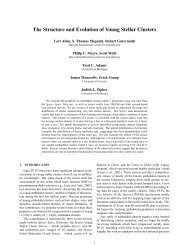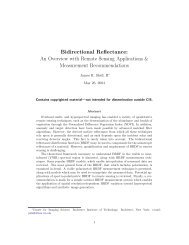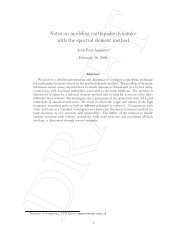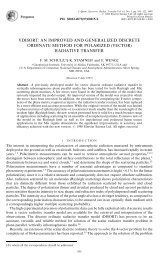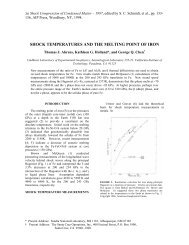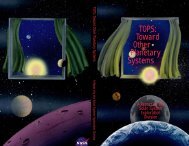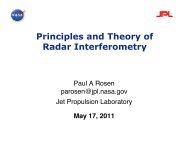and a complete differentiation of the BRDF formulation was developed to generate Jacobianswith respect to surface variables such as the wind speed.Support for maintaining LIDORT Versions 1 and 2 came from a series of contracts over theperiod 1999-2004 which provided the sources of funding for R. Spurr while at SAO. Inrecognition of the need for a consistent set of supported RT codes for use at NASA-GSFC, acontract was set up between SSAI Inc. and RT Solutions Inc. for the developmental release ofLIDORT Versions 3.0 and beyond; all subsequent User <strong>Guide</strong>s were written under this aegis.From Version 3.0 onwards, all previous LIDORT codes are integrated. The last of the olderversions to be incorporated was Version 2.5; this had the specialist ability for fast generation oftotal column (as opposed to profile) Jacobians, and this capability was integrated into LIDORT3.3 in May 2007. New features for Versions 1.0 to 3.3 are (1) a Green’s function treatment of theRTE with atmospheric thermal emission; (2); a new outgoing sphericity correction that replacesthe old treatment of single scatter along the line-of-sight path; (3) the inclusion of a bulk property(total column) weighting function treatment. A number of other improvements were added,including a stand-alone facility for returning the single scatter radiance and Jacobians, anadditional scaling procedure for the single scatter RTE, and an internal adjustment to utilizegeometrical variables at any height in the atmosphere.1.2.2. <strong>VLIDORT</strong> Development, Versions 1.0 to 2.4In December 2003, a proposal was made to FMI for R. Spurr to develop the vector model<strong>VLIDORT</strong> as part of the O3SAF Visiting Scientist (VS) program in 2004. The first version of<strong>VLIDORT</strong> was completed in July 2004, given shakedown tests and validated against theCoulson/Dave/Sekera Rayleigh results [Coulson et al., 1960] and Siewert’s [Siewert, 2000b]benchmark results. The first application started in August 2004 with polarization sensitivitystudies on the UV product algorithm at FMI, and the Version 1.0 User’s guide appeared inSeptember 2004.In January 2005, a proposal was made and accepted for the continuation of <strong>VLIDORT</strong> studies aspart of the Ozone SAF Visiting Scientist Work in 2005. A number of <strong>VLIDORT</strong> improvements(refractive geometry, single scatter corrections, and performance enhancements) were made inspring 2005, and this was followed by an end-to-end linearization of the code, so that the newversion of <strong>VLIDORT</strong> now possessed a complete weighting-function capability. This December2005 version marked the completion of the initial <strong>VLIDORT</strong> development [Spurr, 2006] Afurther validation against the benchmark results of [Garcia and Siewert, 1989] was performed atthis time.Support for <strong>VLIDORT</strong> maintenance and development from 2006 has come from an RTSolutions’ contract with SSAI and NASA GSFC. The first new development for LIDORT and<strong>VLIDORT</strong> was the introduction of a new and more accurate single scatter scheme to allow forspherical geometry along the view path as well as the solar paths. The model has been usedextensively at NASA GSFC in OMI-related studies, and in spring 2007, it was carefullyvalidated against the older TOMRAD code at GSFC.For <strong>VLIDORT</strong> version 2.4R, the linearization facility was extended to include column or bulkproperty Jacobians, a facility that was introduced into the scalar LIDORT code in 2003. Inaddition to the new bulk Jacobian facility, version 2.4R also contains some new BRDFspecifications for polarized reflectance from land surfaces. Thermal emission was introducedinto this version of the code.10
In 2006, R. Spurr was invited to contribute a chapter on the LIDORT and <strong>VLIDORT</strong> models inthe book Light Scattering Reviews 3. This article [Spurr, 2008] contains a complete expositionof the theory behind the models, and the mathematical description in the present volume followsthis review article closely.1.2.3. LIDORT/<strong>VLIDORT</strong> Fortran 90 versions (3.5-3.6, 2.5-2.6)In recent years, many users have moved over to Fortran 90 programming for LIDORT and<strong>VLIDORT</strong> applications; among other reasons, this has necessitated a complete revision of thesoftware. In 2010, the LIDORT code was translated to Fortran 90 (Version 3.5), followed by<strong>VLIDORT</strong> in 2011 (Version 2.5). [Fortran 77 versions of these packages are still supported,though Version 2.6 of <strong>VLIDORT</strong> is only available in Fortran 90]. Although there has been littlenew physics introduced in these versions, the <strong>VLIDORT</strong> and LIDORT organization and codinghas been overhauled in order to bring the codes in line with modern computing standards. Animportant consideration has been the need for the codes to function in a parallel computingenvironment; this has meant that all COMMON blocks and associated "include" files have beenscrapped, to be replaced by explicit argument declarations for all inputs and outputs.With one exception (LIDORT has some capability to be used in parallel-computingenvironments), the LIDORT and <strong>VLIDORT</strong> packages have equivalent capability. Here, we listthe following attributes for <strong>VLIDORT</strong> Versions 2.5 and 2.6 (upgrades for the latter version arenoted separately):1. With the exception of the file <strong>VLIDORT</strong>.PARS, which contains only parameterstatements for symbolic array dimensioning, fixed indices and fixed numerical constants,all "include" files in previous Fortran 77 versions of <strong>VLIDORT</strong> have been removed.2. All variables are explicitly declared, and all input and output arguments clearly notated assuch. All routines have "implicit none" opening statements. All "GO TO" statementshave been removed.3. All Fortran 90 subroutine argument declarations have the intent(in), intent(out) andintent(inout) characterizations. Fortran 90 input and output arguments to the top-level<strong>VLIDORT</strong> calling routines are organized into a number of Type structures.4. A new exception handling system has been introduced. Formerly, input-check andcalculation errors were written to file as they occurred during model execution. This isnot convenient for applications where <strong>VLIDORT</strong> is embedded in a larger system; now,<strong>VLIDORT</strong> 2.5 will collect messages for output, and return error traces.5. The multi-kernel BRDF implementation has been moved out of the main <strong>VLIDORT</strong>model, and now exists as a supplement. <strong>VLIDORT</strong> will now ingest exact BRDFs (for usein single scatter corrections) and for the multiple scatter field, all Fourier components ofthe total BRDF (and any surface property derivatives) at discrete ordinate, solar andviewing angle stream directions. The BRDF supplement provides these inputs.6. The use of "normalized" weighting functions output has been discontinued for surfacelinearization. This makes it possible for example to define an albedo weighting functionin the limit of zero albedo.7. The new <strong>VLIDORT</strong> package has 2 master routines: one for intensity simulations alone,and a second (called the "LPCS" master) for calculations of atmospheric profile orcolumn weighting functions and surface property Jacobians.11
- Page 1: User’s GuideVLIDORTVersion 2.6Rob
- Page 5 and 6: Table of Contents1H1. Introduction
- Page 7 and 8: 1. Introduction to VLIDORT1.1. Hist
- Page 9: Table 1.1 Major features of LIDORT
- Page 13: corrections, and sphericity correct
- Page 16 and 17: Matrix Π relates scattering and in
- Page 18 and 19: m⎛ P⎞l( μ)0 0 0⎜⎟mmm ⎜ 0
- Page 20 and 21: In the following sections, we suppr
- Page 22 and 23: of the single scatter albedo ω and
- Page 24 and 25: Here T n−1 is the solar beam tran
- Page 26 and 27: ~ + ~ ~ (1)~ ~ + ~ ~ (2)~ ~ − ~ 1
- Page 28 and 29: The solution proceeds first by the
- Page 30 and 31: Linearizations. Derivatives of all
- Page 32 and 33: For the plane-parallel case, we hav
- Page 34 and 35: One of the features of the above ou
- Page 36 and 37: L↑↑ ↑k (cot n −cotn −1)[
- Page 38 and 39: Note the use of the profile-column
- Page 40 and 41: βl,aer(1)(2)fz1e1βl+ ( 1−f ) z2
- Page 42 and 43: For BRDF input, it is necessary for
- Page 44 and 45: streams were used in the half space
- Page 46 and 47: anded tri-diagonal matrix A contain
- Page 48 and 49: in place to aid with the LU-decompo
- Page 50 and 51: In earlier versions of LIDORT and V
- Page 53 and 54: 4. The VLIDORT 2.6 package4.1. Over
- Page 55 and 56: (discrete ordinates), so that dimen
- Page 57 and 58: Table 4.2 Summary of VLIDORT I/O Ty
- Page 59 and 60: Table 4.3. Module files in VLIDORT
- Page 61 and 62:
Finally, modules vlidort_ls_correct
- Page 63 and 64:
end program main_VLIDORT4.3.2. Conf
- Page 65 and 66:
$(VLID_DEF_PATH)/vlidort_sup_brdf_d
- Page 67 and 68:
Finally, the command to build the d
- Page 69 and 70:
Here, “s” indicates you want to
- Page 71 and 72:
The main difference between “vlid
- Page 73 and 74:
to both VLIDORT and the given VSLEA
- Page 75 and 76:
STATUS_INPUTREAD is equal to 4 (VLI
- Page 77 and 78:
5. ReferencesAnderson, E., Z. Bai,
- Page 79 and 80:
Mishchenko, M.I., and L.D. Travis,
- Page 81:
Stamnes K., S-C. Tsay, W. Wiscombe,
- Page 84 and 85:
Table A2: Type Structure VLIDORT_Fi
- Page 86 and 87:
DO_WRITE_FOURIER Logical (I) Flag f
- Page 88 and 89:
USER_LEVELS (o) Real*8 (IO) Array o
- Page 90 and 91:
angle s, Stokes parameter S, and di
- Page 92 and 93:
DO_SLEAVE_WFS Logical (IO) Flag for
- Page 94 and 95:
6.1.1.8. VLIDORT linearized outputs
- Page 96 and 97:
NFINELAYERS Integer Number of fine
- Page 98 and 99:
6.1.2.4. VLIDORT linearized modifie
- Page 100 and 101:
The output file contains (for all 3
- Page 102 and 103:
The first call is the baseline calc
- Page 104 and 105:
for a 2-parameter Gamma-function si
- Page 106 and 107:
Remark. In VLIDORT, the BRDF is a 4
- Page 108 and 109:
6.3.3.1. Input and output type stru
- Page 110 and 111:
Table C: Type Structure VBRDF_LinSu
- Page 112 and 113:
Special note regarding Cox-Munk typ
- Page 114 and 115:
squared parameter, so that Jacobian
- Page 116 and 117:
6.4. SLEAVE SupplementHere, the sur
- Page 118 and 119:
is possible to define Jacobians wit
- Page 120 and 121:
etween 0 and 90 degrees.N_USER_OBSG
- Page 122:
6.4.4.2 SLEAVE configuration file c



